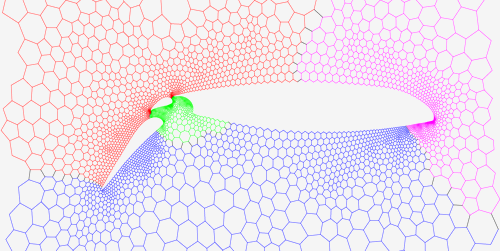KaHIP – Karlsruhe High Quality Partitioning
From the webpage:
The graph partitioning problem asks for a division of a graph’s node set into k equally sized blocks such that the number of edges that run between the blocks is minimized. An example graph that is partitioned into four blocks:
KaHIP – Karlsruhe High Quality Partitioning – is a family of graph partitioning programs. It includes KaFFPa (Karlsruhe Fast Flow Partitioner) in its variants Strong, Eco and Fast, KaFFPaE (KaFFPaEvolutionary) which is a parallel evolutionary algorithm that uses KaFFPa to provide combine and mutation operations, as well as KaBaPE which extends the evolutionary algorithm. Moreover, specialized techniques are included to partition road networks (Buffoon) and to output a vertex separator from a given partition.
Licence
The program is licenced under GPL 3.0. Please let us know if you need a commercial licence.
If you publish results using our algorithms, please acknowledge our work by quoting the following paper:
@inproceedings{sandersschulz2013,
AUTHOR = {Sanders, Peter and Schulz, Christian},
TITLE = {{Think Locally, Act Globally: Highly Balanced Graph Partitioning}},
BOOKTITLE = {Proceedings of the 12th International Symposium on Experimental Algorithms (SEA’13)},
SERIES = {LNCS},
PUBLISHER = {Springer},
YEAR = {2013},
VOLUME = {7933}
PAGES = {164–175}
}The algorithms that are included for download are mainly based on the following publications:
- Peter Sanders and Christian Schulz. Engineering Multilevel Graph Partitioning Algorithms. In Proceedings of the 19th European Symposium on Algorithms (ESA’11), volume 6942 of LNCS, pages 469–480. Springer, 2011. Download PDF.
- Peter Sanders and Christian Schulz. Distributed Evolutionary Graph Partitioning. In Proceedings of the 12th Workshop on Algorithm Engineering and Experimentation (ALENEX’12), pages 16–19, 2012. Download PDF.
- Peter Sanders and Christian Schulz. High Quality Graph Partitioning. In Proceedings of the 10th DIMACS Implementation Challenge Workshop: Graph Partitioning and Graph Clustering, pages 1–17, AMS, 2013. Download PDF.
- Peter Sanders and Christian Schulz. Think Locally, Act Globally: Highly Balanced Graph Partitioning. In Proceedings of the 12th International Symposium on Experimental Algorithms (SEA’13), volume 7933 of LNCS, pages 164–175, 2013. Download PDF.
- Christian Schulz. High Quality Graph Partitioning. PhD thesis. Karlsruhe Institute of Technology, 2013.
ISBN 978-3844264623, epubli GmbH. Download PDF.Download
- KaHIP_0.53.tar.gz (or available on GitHub here)
- User Guide to KaHIP v0.53
- Note: this release does NOT contain natural cuts due to an US software patent. If you want to use specialized techniques for road networks, e.g. Buffoon, please send us an email.
News of interest to the graph side of the house!
And topic maps for the same reason. That is obtaining the smallest number of associations that run across partitions.
Although, due to merging, topic maps present additional complications. It isn’t possible to predict when additions to one partition may result in merges across one or more partitions.
I’m not sure how that would be anticipated except by restrictions on merging rules. Suggestions?
I first saw this at: Enhancing Efficiency of Complex Computations.
